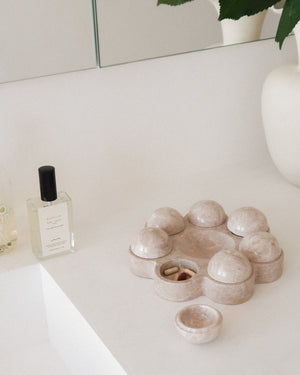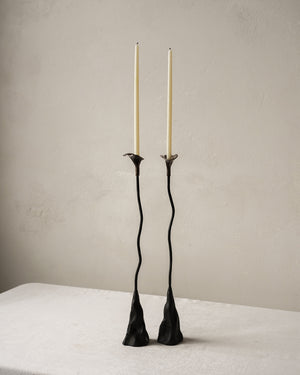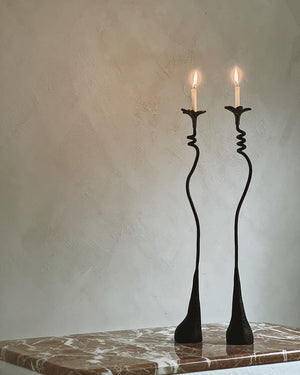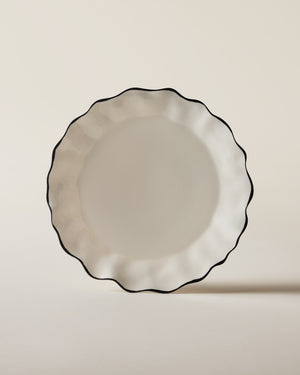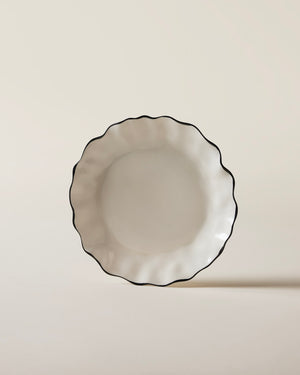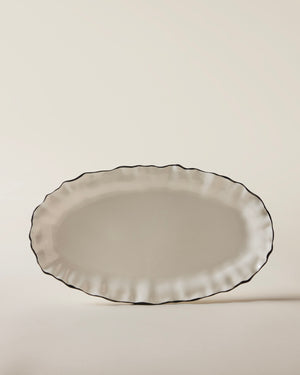IN CONVERSATION WITH ANNALEACLELIA TUNESI
AnnaLeaClelia (Lea) Tunesi's practice is deeply informed by her knowledge of art history. Born and raised in Italy, Lea moved to London in 2000. After suffering a terrible car crash that left her temporarily unable to walk, Lea, who has been an artist her whole life, went back to school, receiving her Ph.D. in Museology from the University of Leeds in 2014. After graduating, she returned to making artwork. Lea's ceramic sculptures, which resemble miraculously intact pottery dug up from ancient historical sites, pay homage to artifacts from the past while at the same time reflecting her present experiences. Lea hopes they anticipate the future. She calls them contemporary archaeology.

Lauren Sands sat down to talk to Lea about how her education informs her work, what objects she collects, and why she chose clay as her medium.
Lauren Sands: What first brought you to art?
AnnaLeaClelia Tunesi: The real beginning was that my parents didn't know what to do with me, and they said art is probably the only thing [laughs]. I was born a very manual and creative person. I went to Liceo artistico, a secondary school focused on art. Then I went on to study art and set design at the Accademia di Belle Arti di Brera in Milan. I worked as a set designer for 15 years. After that, I received my Ph.D. When I was working towards my Ph.D., I made pottery, and since then, I've never stopped.

LS: How has your academic training, and primarily your Ph.D., influenced your art practice?
AT: Enormously. It is the most rewarding aspect of my career. I was going to sign a contract [to design sets] for a long series of commercials, and then I had a tremendous car crash. I broke my two legs. I couldn't walk for many years. I realized I needed to do something for my brain's creativity because the experience was heavy to manage. So I thought, 'I'll carry on studying something related to art collecting because I am a collector myself.' Maybe I'm a hoarder. [Laughs.] I studied the true meaning of art collecting through the lens of prominent managing families in Italy, Germany, and Austria from the 15th century, such as the Medici family. I got furious about this subject! My Ph.D. project was based on this fantastic museum in Florence called the Museo Bardini. Stefano Bardini was a significant art dealer at the end of the 19th century. He collected a lot of Renaissance and medieval fragments [of masterpieces.] For four years, I analyzed his work. When I finished my Ph.D., I was done with the theory, and I wanted to get back to my manual, physical creativity. That's why I invented contemporary archaeology.
LS: Can you tell me a bit about your series "contemporary archaeology"?
AT: I did my Ph.D. project at the Stefano Bardini Museum in Florence. (If you haven't heard of it, you must go.) Bardini was a 19th-century art dealer whose collection was full of fragments. Many of the artifacts—vases, furniture, altarpieces—in Italy were destroyed by crises and war, and Bardini seamlessly restored their original forms using fragments. This was the aesthetic at the time, and it is what collectors wanted. When I was done with my Ph.D., I wanted to make objects influenced by Bardini. I created contemporary archaeology, an art form that mimics the restoration of ancient artifacts as evinced by Bardini. I wanted to make something perfect that was also imperfect. Objects that are originals but have all the qualities of a reconstituted artifact. That is contemporary archaeology.


LS: Can you talk about the tension between the past and contemporary art and how you use that tension?
AT: Inevitably, when you recreate the past, the addition of modernity is there because you do it 'now.' I can't copy the past; it would be boring. But the past integrated with the present is like an endless history. I recently made these pink pieces. I call them contemporary archaeology goes Pop because Pop Art was trying to reimagine the past in the present. [I want to combine the] past, present, and something weird together, because I don't know exactly what the future will bring.
LS: Why is clay your medium of choice?
AT: I started using clay when I came to live in England in 2000. Clay is the first medium humans used to make plates and other things. There is a very subtle pleasure in connecting with clay. It took me a long time to understand the medium. It's only in the last ten years that I realized that you could combine sculpture and painting—one of my pots in the LES Collection is just painted sand on clay. I love the materiality. Ceramics can be whatever you like as long as you know where you're going.


LS: When you set out to create work, do you have a very thought-out plan or is it a more organic process?
AT: I think of something I want to make, maybe something I saw in a museum that impressed me. I cannot plan something and stick to the plan because the moment you start to work on it, to build on it, it takes on different shapes. I let myself go.

LS: Can you tell me about your collection of art? What do you collect?
AT: I collect those super tacky plastic monuments you buy in cities. Wherever I go, I try to buy one. It's a bizarre collection. I also have a lot of glasses. I go to Venice a lot. I have a place there. I collect glasses to drink that are invaluable. Whatever has a three-dimensional shape; I don't collect paintings. I'm a hoarder, probably—a good hoarder.
LS: I like "a collector" better. [Laughs.] What drew you to work with LES Collection?
AT: I could see you knew what you were doing. I don't give my pieces to people who don't understand them. [As an artist], you hope to collaborate with people who are on the same wavelength. The objects LES Collection are selling are exciting, and there is an idea behind them—it's not random. I trust you.
All images shot by Toby Ziff
